PSYC*3290: States level 3 (Week 2)
1/116
There's no tags or description
Looks like no tags are added yet.
Name | Mastery | Learn | Test | Matching | Spaced |
|---|
No study sessions yet.
117 Terms
The Dance of the mean
• Taking the means of many samples
helps visualize differences between
samples and how they relate to the
population.
• These differences can be seen in the
dance of the means to the right
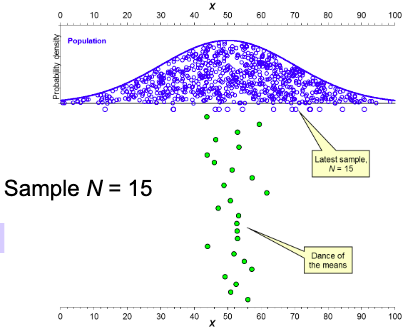
When we have a large N in the dance of the Mean
• Larger sample N usually comes closer
to estimating μ, so the dance is
narrower.
• Smaller samples vary more
dramatically.
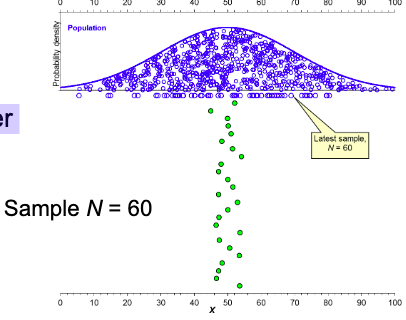
In the Dance of the Mean
• Because of sampling variability, we
can expect to see a range of means—
however, they generally stay within a
reasonable range around μ.
You’ll that the mean heap is
normally distributed; In other words, it
has a mean and a SD like any other
normal distribution.
The mean heap is referred to as the
sampling distribution of sample
means
What is the SD of the sampling distribution of the sample mean
The standard error of the mean (SEM)
The standard error of the mean (SEM) tells us
How precise our estimate of µ is
The sampling distribution of the sample mean estimates
the population mean µ
What is the Margin of Error (MoE)
It is the combination of
1: the z- score for 95% of a normal distribution (1.96)
2: The formula for the (SEM) σ/srt of N
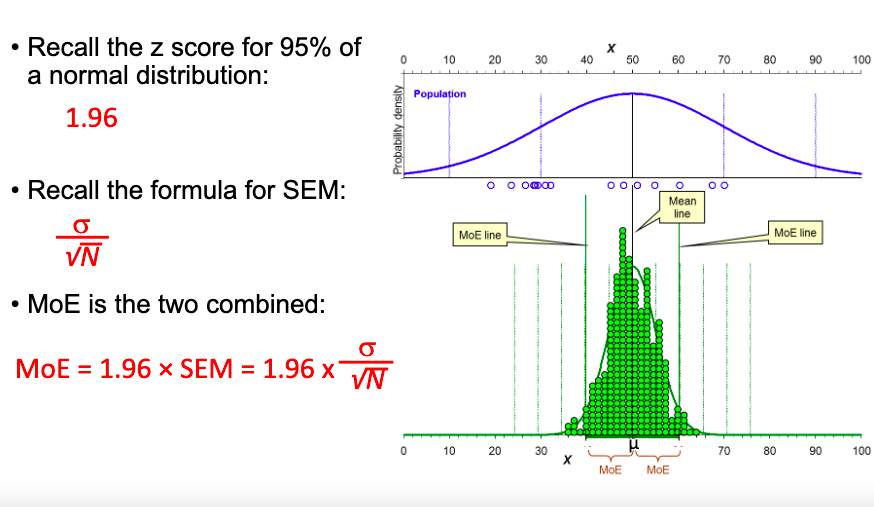
In CI, if σ is known, we can calculate it.
-Always remember, CI account the (MoE) for above & below the mean
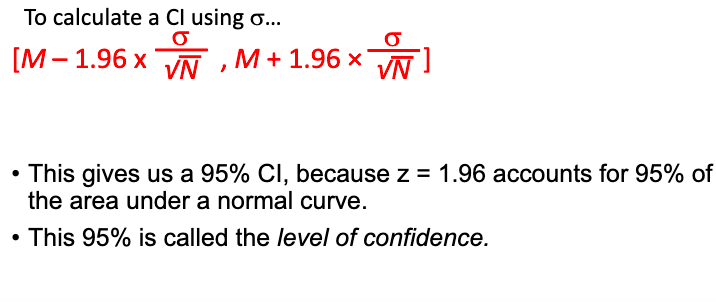
What is the dance of the CI
-the dance of the CIs tells us about the
value of μ.
• Although random sampling means
that most M values don’t equal μ,
most CIs contain μ.
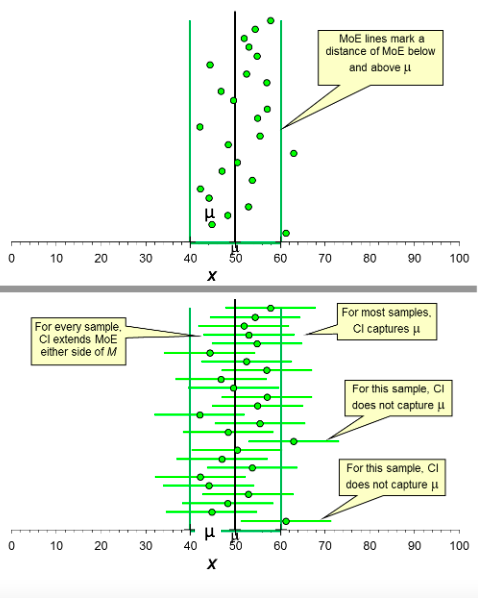
Our best information about σ is in
s, the SD of our sample.
If we don’t known σ and we need to calculate the Z score, our solution is
T - scores
The t-distribution
-is very similar to the normal distribution, but with higher tails.
• This is because, not only does our estimate of μ vary from sample to sample,
but now our estimate of s does too!!
Unlike z - score that have a 1.96, t - scores have a
2.145
Calculating the t - distribution requires a new piece of information called the
Degrees of Freedom

Recall that we can express estimation error of the population mean (M – μ), as a z-score:
Calculating a t-score is very similar. We simply substitute s (our sample SD) in place of s:
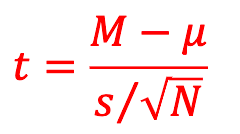
What is the degrees of freedom
Df = N - 1
Calculating a t-score is very similar. We simply substitute s (our sample SD) in place of s:
When σ is unknown, we replace 1.96 with tC/100 (df), and use s instead of s

In CI when σ is not known,
However, when s is
unknown, CIs are more
dependent on s values, which
vary from sample to sample.
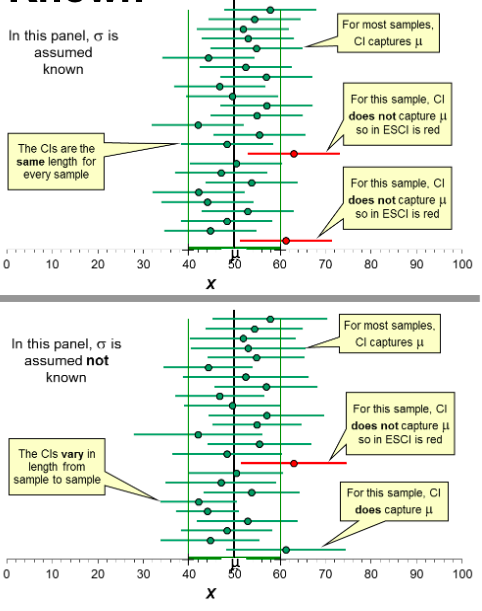
What are the four main approaches to interpreting the CI
1. Our CI is one from the dance
2. The cat’s eye picture helps interpret our CI
3. MoE gives the precision
4. Our CI gives useful information about replication
While we can’t know for sure if our CI gives us valuable information about μ, we always know:
• Our CI is randomly chosen from the dance
• It might include μ , and represent the dance
• It may be red, and not represent the dance
Cat’s Eye Picture
• The cat’s eye tells us about
plausibility.
• A CI has C% likelihood of
capturing μ, graphically
illustrated in a cat’s eye.
• Finding a value for μ
toward the center of CI is
more likely than finding a
value out toward the tails
or beyond.
• Be careful: even CIs with
cat’s eye pictures can still
be red—the picture only
tells us likely values of μ,
not definite.
MoE gives
Precision
MoE indicates how close our
point estimate is likely to be to μ
Higher MoE means
Lower precision
Lower MoE means
Higher precision
A CI can also be thought of as a
prediction interval for replication means
A replication mean is the mean obtained in a
Close Replication
Though less precise than for μ, our CI
can help us predict replication
M
The dance
Our CI is a random one from an infinite sequence, the dance of the CIs. In the
long run, 95% capture mu and 5% miss, so our CI might be red
Cat’s eye picture
Interpret our interval, provided N is not very small and our CI hasn’t been
selected. The cat’s eye picture shows how plausibility, or likelihood, varies
across and beyond the CI—greatest around M and decreasing smoothly further
from M. There is no sharp change at the limits. We’re 95% confident our CI
includes m. Interpret points in the interval, including M and the lower and upper
CI limits.
MoE
MoE of the 95% CI gives the precision of estimation. It’s the likely maximum
error of estimation, although larger errors are possible
Prediction
A 95% CI provides useful information about replication. On average there’s a
.83 chance (about a 5 in 6 chance) that a 95% CI will capture the next mean
The dominant approach to testing such hypotheses is called
null hypothesis significance testing (NHST)
What is a null hypothesis?
• The skeptical hypothesis - that there is no effect
• ”the mean IQ of U of Guelph students is equal to 100”
• What is an alternative hypothesis?
• Mutually exclusive with null hypothesis – predicts a difference!
• “the mean IQ of U of Guelph students is not equal to 100”
NHST steps:
• 1) Formulate a null hypothesis
• ”the mean IQ of U of Guelph students is equal to 100”
• 2) Collect a sample of data from population of interest
• Get a sample of U of G students and measure their IQ
• 3) Evaluate likelihood of obtaining your data if the null
hypothesis were in fact true
• Given the mean and SD in your sample, how likely is it that your
sample came from a population with a mean of 100?
p – values:
Tells us the likelihood of obtaining our result, or a
result more extreme IF the null hypothesis were true
we reject the null
hypothesis
If tobt > tcrit
we fail to reject the null
hypothesis
If tobt ≤ tcrit
The cats eye shows us that
The curve tells us that in most cases, M is close to the population mean
The cats eye picture is the
Widest or fattest at M, which tells us that most means fall close to the population mean and progressively fewer means fall at positions further away from the population mean
The cats eyes also tells us
Most likely, Mu is close to M, and likelihood drops progressively for values of Mu farther away from M, out to the limits of the CI and beyond
Where the cats eyes is the widest
It is the widest around M, which tells us that our best bet for where Mu lies is close to M
The Null hypothesis
States, for testing, a single value of the population parameter
The smaller the p value
The more unlikely are the results like ours, If the null hypothesis is true
The NHST compares
P with the significance level, often .05. If P is less than that level, we reject the null hypothesis and declare the effect to be statistically significant
Strict NHST requires
The significance level to be stated in advanced. However, researchers usually don’t do that but use one of the a few conventional significance levels
the significance level
Is the criterion for deciding whether or not to reject the null hypothesis. If the p value is less than the significance level, reject, if not then don’t reject
If P> .05
the null hypothesis was not rejected, p > .05
If p< .05 (but p>.01)
the null hypothesis was rejected, p<.05 or rejected at the .05 level
If p <.01 (but p>.001)
The null hypothesis was rejected, p <.01 or rejected at the .01 level
If p <.001
The null hypothesis was rejected, p,.001 or rejected at the .001 level
Why .05 and not 0.05
That’s apa style for a quantity
A lower significance level (.01 rather than .05)
Requires a smaller p value, which provides stronger evidence against the null hypothesis
If using NHST
Report the p value itself (e.g., p = .14), not only a relative value (e.g., p> .05)
For the .05 significance level,
Reject the null hypothesis if it’s value lies outside the 95% CI>
If inside, don’t reject
The further our sample result, the CI, falls from the null hypothesis value
The smaller the p value and the stronger the evidence against the null hypothesis
The plausibility picture illustrates
How strength of evidence varies inversely with plausibility of values, across and beyond the CI
Prefer Hypothesis Evaluation for a fuller
More useful interpretation than only a yes and no reject or don’t reject decision
Hypothesis Evaluation
Focuses on interpretation in terms of strength of evidence or degrees of plausibility, rather than merely rejecting or not rejecting a hypothesis
The Null hypothesis is
H0 and the null hypothesis value is of the population mean is µ0
The p - value
is the probability, calculated using a stated statistical model, of obtaining the observed result or more extreme, if the null hyposthesis is true
What do we use to calculate the p value when we are willing to assume σ is known
Z
Z score when H0 is true
Z = (M - µ0) / σ/ str N
A test statistic
Is the statistic with a known distribution, when H0 is true, that allows calculations of a p value
If a 95% CI falls so that μ0 is about one -third of MoE beyond a limit
p = .01, approximately
As our mean moves farther away from the population mean
Our P value begins to lower as well
P > .05
So the CI must extend past μ0. the larger the P, the further the CI extends past μ0
P < .05
So the CI extends only part way towards μ0, the smaller the p, the shorter the CI in relation to μ0
If p >.05, the 95% Ci
extends past μ0 and the larger the p, the further it extends.
If p< .05
The CI doesn’t extends as far as μ0 , and the smaller the p, the shorter the CI
Eyeballing the CI
May be the best way to interpret a p value.
If p is around .05, the CI extends from M to close to μ0
Dichotomous thinking
Focuses on two mutually exlusive alternative.
the dichotomous reject or don’t reject decisions of NHST tend to elicit dichotomous thinking
Estimation Thinking
Focuses on how much by focusing on point and interval estimates
The inverse probability fallacy
Is the incorrect belief that the p value is the probability that H0 is true
The p value
Is not the probability the results are due to chance
That’s another version of the inverse probility fallacy
The dance of the p values
Is veru wide. a p value gives only very vague information about the dance
By convention, stars are used to indicate strength of evidence against H0
1: P <.001, ***
2: P<.01 **
3: P<.05 *
The p value
Gives no indication of uncertainity
The alternative hypothesis H1 states
There is an effect
the alternative hypothesis
Is a statement about the population effect that’s distinct from the null hypothesis
A type 1 error
Is the rejection of H0 when its true
False Positive:
type 2 error
Is failing to reject H0 when it’s false
False negative or miss
type 1 error rate (a)
Is the probability of rejecting H0 when it is true.
Not the probability that H0 is true
type 2 error rate (β )
Is the probability of failing to reject H0 when it is false
False negative
A one tailed p
values indicates values more extreme that the obtained results in one direction
the direction having been stated in advance
When using means
One tailed p is half of two tailed p
A two tailed p
value includes values more extreme in both positive and negative directions
A one sided or directional alternative hypothesis
Includes only values that differ in one direction from the null hypothesis value
One tailed p includes
Values more extreme than the observed result only in the direction specified by the one sided, or directional alternative hypothesis H1
Target Moe
Is the precision we want our study to achieve
Larger N gives
Smaller Moe, and thus higher precision
Precision for planning
Bases choice of N on the MoE the study is likely to give.
Consider N for various values of your target MoE
The MoE distribution
illustrates how MoE varies from study to study
Increases n from 50 to 65 and, on 99% of occasions
the MoE will be less than or equal to a target MoE of 0.4
Assurance
Is the probability, expressed as a % that a study obtains MoE no More than target MoE
For precision for planning
use Cohen’s d
Assumed to be in units of a population SD
A replication should usually have N
at least as large as the N of the original study, and probably larger